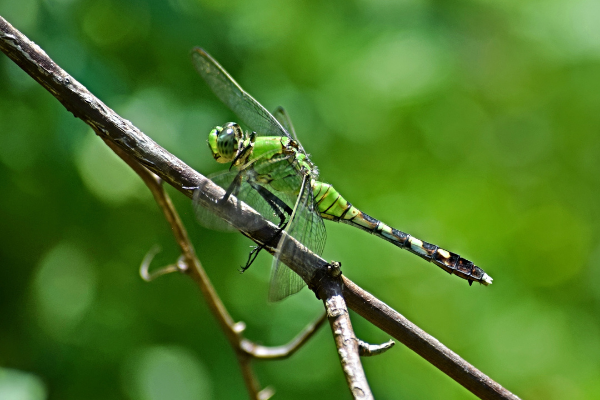One of my favorite things about summer is seeing dragonflies dashing and diving through the air. I always gravitate towards artwork featuring dragonflies since they’ve come to symbolize transformation, looking inward and living life to it its fullest.
But for insects I adore so much, I discovered how little I knew about them, and their damselfly relatives during the “Dazzling Dragonflies” program at Greenwich Audubon July 31. By the way, damselflies have hinges that allow them to fold their wings together when resting, while dragonflies do not—their wings are always outstretched.
Dragonflies are even more fascinating than I thought—there are thousands of species and these ancient predators have been around longer than dinosaurs. Griffenflies, the gigantic precursors to modern dragonflies had wingspans of more than two feet and dotted the skies more than 300 million years ago.
But what surprised me the most is that they are aquatic and spend most of their lives—up to three years—in the water.
Around midsummer female dragonflies deposit their eggs on the water’s surface or insert them into aquatic plants or moss. The eggs hatch in about seven to eight days, and then the nymph dragonfly spends its time hunting mosquito larvae, other aquatic insects and worms, and for a little variety even small aquatic vertebrates like tadpoles and small fish.
After molting somewhere between six and 15 times throughout the years its in the water, a dragonfly nymph is finally ready for adulthood and crawls out of the water to shed its final immature skin.
Adult dragonflies only live up to six months. Like the nymphs, they spend most of their time hunting and that is extremely beneficial to humans. They eat lots of “pests” that also come with summertime— mosquitoes, gnats and flies. The basket formed by their legs allows them to catch insects while flying.
Dragonflies are also beneficial to wildlife, they are prey for frogs, fish and birds—purple martins are particularly fond of them. But dragonflies are not easy prey. They can move each of their four wings independently and move straight up or down, fly backward, stop and hover, and make hairpin turns—at 30 miles an hour or in slow motion.
Because fresh water is so critical to their lifestyle, dragonflies are used as indicators of ecological health of their habitats and as proxies for general biodiversity. Increasingly, dragonflies offer opportunities to alert the public of how humans are changing the natural world and particularly our precious freshwater resources.
So it’s paramount protect these guardians of our watersheds.
In 2009, the first comprehensive assessment of insect species showed that 10 percent of dragonfly species were under threat of extinction, according to National Geographic.
The insects are imperiled by development that destroys their freshwater habitats—particularly ponds, bogs, and fens—pollution, and non-native vegetation. They are also being harmed by pesticides, air pollution and climate change.
If you want to help dragonflies in your own backyard, stop using pesticides and add a water feature. The water should be about 2 feet in depth, protected from the wind and have 6 hours of midday sun every day.
For their best chances of survival, dragonflies (and damselflies) need a few different types of vegetation in and near the water feature. Submerged vegetation gives protection to eggs and nymphs. Emergent vegetation gives nymphs who are turning into adults a path to get out from underwater. Floating plants give adults perches for resting and laying eggs. Plants around the water’s edge and nearby trees and shrubs give adults a place to perch, roost, and seek shelter.
As part of the Audubon program, we ventured outside to conduct a dragonfly survey in the native wildflower meadows and around Georgie’s Pond. We certainly were dazzled by blue dashers, Eastern pondhawks and easter amberwings, to mention a few. No I did not know their names, but was grateful to our guide Ryan Maclean, a bird education specialist, who identified the dragonflies swiftly.
Attendees of all ages were thrilled at all the sightings, which also included several monarch and yellow swallowtail butterfliess and the most delightful hummingbird moth.
Now that I know more about the insect that has captivated me since I was a child, I think the Japanese have it right.
In Japan, dragonflies are revered and respected, being symbolic of happiness, strength, courage and success. To the Japanese, the dragonfly is an important cultural symbol and was believed to be the spirit of the rice plant and a harbinger of rich harvests.
Akitsushmi, which means Dragonfly Island, is an alternative name for Japan.

